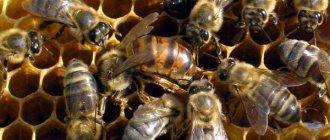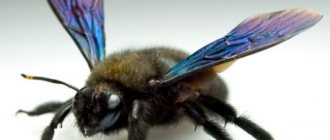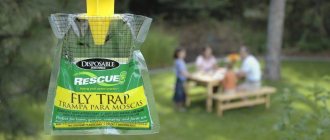Beekeeping is becoming increasingly popular. People breed insects in their dachas, plots, and rural areas. This type of activity has many advantages. There is another side to the coin. People living in the neighborhood are faced with the problem of buzzing insects that come to visit. How to properly deal with your neighbors' bees? How to negotiate with a neighbor and protect yourself? What to do when bitten by angry bees? These questions concern those who are haunted by their neighbor's bees.
Options for resolving the issue: talk to the owner of the apiary, act according to the law, or cope on your own.
How can bees interfere?
Insect bites are dangerous. They sting painfully and secrete poison. People who are prone to allergic reactions are at risk of dying.
Those who have small children should be wary of insects that live in the neighboring area. Insects are not prone to attack, but babies can scare away and provoke an individual to bite or sting.
Provoking factors:
- Lack of honey plants near the apiary;
- Aggressive queen of the family;
- Wet, rainy weather;
- Smoke, smell of tobacco, alcohol;
- Swarming period.
Swarming swarms of bees are dangerous. They group on bushes and trees in large numbers. In the presence of provoking factors, they attack people and animals. If you have observed swarming or aggressiveness of bees, think about how to get rid of neighbor bees in your garden plot.
Actions after a bite
First aid for a bee sting consists of the following:
- it is necessary to inspect the bite site and remove the sting with clean hands or tweezers treated with any alcohol-containing substance;
- the bite site should be treated with alcohol, hydrogen peroxide or a weak solution of potassium permanganate;
- apply a cold compress to the bite site to relieve swelling and reduce pain;
- drink water, or even better still mineral water or sweet tea;
- if you have an allergy, take an antihistamine;
- If you feel unwell, call a doctor at home.
If you are very worried about a swarm of bees and you know that the hives belong to a neighbor, then you need to record the bites for information. To do this, you must consult a doctor. Certificates will help you gather evidence that bees are seriously ruining your life and you need to get rid of them.
You can also try an ultrasonic insect repeller or even place several around the area. They now cost pennies - https://aliexpress.ru
Negotiations with apiary owners
There are several ways to get rid of your neighbor's pets. When the neighbor is a peace-loving person, explain the reason for the fears. Offer options for solving the problem, think about what to do.
Inspect your area for water sources. Bee families fly into other people's properties in search of water. If there are unprotected containers or reservoirs with liquid, pour granulated sugar there. This will discourage the inhabitants of the hives from flying for water.
Peaceful solutions
Think about how to behave when your neighbor’s bees are bothering you, where to complain, what to do to avoid open conflict with the owner of the apiary. Before resorting to drastic measures, talk to a beekeeper.
Solutions:
- If your neighbor has an apiary and the hives are turned towards your house, ask them to turn them in the opposite direction;
- Change the fence separating the areas (height at least 2.5 meters);
- If these are wild, aggressive individuals that have stung you and your family members more than once, recommend getting a peaceful type of insect;
- Plant tall shrubs along the perimeter of the fence;
- Move bee houses away from your territory (at least 25-30 meters). This is beneficial for the neighbor beekeeper. Changing the location of pollen collection increases the yield;
- Change the queen of the bee family.
The reason for the manifestation of unfriendliness and aggression often lies in the uterus. If it is replaced, the individuals will become less aggressive.
Legal solutions
If your neighbor's bees haunt you, where to turn and what to do, you will find out by studying the legislation. When attempts to resolve the problem peacefully are unsuccessful, explore legal options to resolve the situation.
Go to court. You'll need proof that your neighbor's pets are biting and you don't know what to do.
Algorithm of actions:
- After a bite, go to a medical center for qualified help. Ask your doctor for a certificate stating the fact of the bite.
- Check the distance at which the hives are installed from the property line. The norm is at least 3-4 meters.
- Measure the height of the dividing fence.
- If bee colonies are swarming in your area, take a photo or video.
- When a person has bees on his property, ask if he has documents: an apiary passport, an apiary registration book. The book contains a note from a beekeeping inspector stating that the beekeeper is trained in the rules of behavior when attacked by bees.
It is necessary to fight bees with the help of the law, having documented evidence that they cause harm to health and cause discomfort.
Try to solve the problem peacefully
The first option on how to get rid of annoying neighbor bees is to negotiate with a beekeeper. If he is adequate and thinks sensibly, then he will agree to compromise terms. To resolve the conflict, it is recommended to propose a method of resolving the situation:
- The beekeeper replaces the breed of his “pets” with more peaceful individuals. For example, Karnik bees are distinguished by their friendliness, rare display of aggression, and hard work. The beekeeper also benefits from this option.
- Installation of a solid fence with a height of at least 2 meters. This will limit the flight of insects.
- Planting shrubs and trees that grow quickly between your own territory and the hives.
- Relocation of bee houses from nearby residential buildings. The minimum distance is 30 meters. In this situation, insects will be able to live and work peacefully without disturbing others.
- Change of mother. Often the reason for the aggression of working women is the embitterment of the queen bee. If you replace it, the insects will become calmer.
The most favorable option is to agree to move the apiary to another area, away from the populated area. With the right choice of site, you can increase the productivity of beekeeping activities, which will be a pleasant bonus for the beekeeper.
Deliverance by law
The Constitution of the Russian Federation says that the right to freedom is given to every person. A beekeeper who is indifferent to requests from residents to solve the problem is held accountable for non-compliance with the requirements of Article 10. The article refers to the illegality of activities that restrict a person’s right to freedom, health protection, and a favorable living atmosphere.
If residents of the locality living next to the beekeeper have a certificate confirming the facts of the bite, write a statement to the local police officer and attach a copy of the paper. Law enforcement officials will conduct an inspection to determine the legality of beekeeping, compliance with rules, and standards for maintaining hives. They will instruct you on how to behave and how to properly deal with a neighbor beekeeper who is indifferent to requests for a peaceful solution to the problem.
How to get rid of your neighbor's annoying bees at your dacha? When they attack you at your dacha, file a statement with the management of the gardening partnership. Attach a medical examination of the bite site and the consequences for the victim’s health. The manager of the partnership will check the documentation and hold the owner of the hives accountable.
Danger and harm of bees
The main danger of bees is their stings, through which toxic substances enter the human body. The presence of an allergy to the poison contained in the plant is provoked by the entry into the human body of a significant amount of toxic elements, including peptides and histamine.
Numerous bites often cause severe swelling and, in some cases, death. Women, older people and children are more sensitive to Hymenoptera venom.
What plants do honey producers dislike?
If the inhabitants of the apiary are bothering you, buzzing, swarming, biting, and you don’t know how to get rid of your neighbor’s bees, use what they are afraid of – sharp-smelling plants.
Some plants are capable of disarming uninvited guests, while others can destroy or poison.
Plants that protect against bites:
- Mint . Honey extractors hate sharp, specific odors. Mint is used as a means to protect against them. Trays with mint infusions are placed around the perimeter of the site. On the fence hang rags soaked in mint infusions, peppermint and essential oils.
- Carnation . Similar to mint, it scares away and forces honey miners to avoid the unpleasant smell and fly around the area.
- Wormwood . If the neighbor's bees are bothering you, plant a plant around the perimeter and hang bunches of dried wormwood in the yard.
- Geranium.
If you have a beekeeper in your neighborhood who is causing a nuisance, catnip is an effective way to control your neighbor's insects. The plant is planted along the border of the site on the beekeeper’s side, dried, hung in the yard, a fire is lit, and grass is thrown there.
Plants that are toxic, dangerous, poisonous:
| Name | Characteristic |
| Henbane | You can poison all your neighbor's pets. Causes the death of an entire swarm. |
| Aconite | Poisonous plant. Aconite is capable of destroying a large number of bee colonies. |
| Hellebore | If there are dangerous insects in the neighboring area, then hellebore will help get rid of them. It is a toxic plant. |
Poisonous plants should be used with caution. They harm insects and humans if they eat honey that was obtained by poisoned insects.
What scares you away
If you are unable to come to an agreement with your neighbor, and you don’t dare go to court or poison your neighbor’s bees, you can try to scare them away. There are several effective ways to repel insects:
- pieces of fabric soaked in essential oils of mint, cloves or mustard, an aroma lamp in the garden on a table are humane options for getting rid of bees that cannot tolerate odors;
- bags of mothballs, which can be hung on trees and in places where insects accumulate, can serve as repellers;
- near the fence you can plant a perennial herbaceous plant, catnip, the smell of which will prevent insects from entering your area;
- You can hang traps with vinegar near a container of water or along the fence, the smell of which bees don’t like;
- an audio recording of birds singing will create a special atmosphere in your garden and scare away bees;
- Purchased repellers with different operating principles are very effective in fighting insects, including bees.
Methods of disposal
The methods listed below will tell you how to deal with annoying neighbor bees.
Before going to extreme measures, be sure to make sure that you have done everything necessary:
- If your neighbors have bees that sting and you don't know what to do, talk to the owner.
- Get rid of bees on your property using folk remedies.
- Use of insect repellents.
What to do, how to act if your neighbor has honey miners who don’t give him peace? Of course, the use of insect repellents. To understand how to protect yourself from your neighbor’s aggressive insects by using repellers, study the principle of operation:
- Lamps. They attract neighboring insects using ultraviolet light and shock them.
- Ultrasonic devices . The waves they emit scare away and kill uninvited guests.
- Special lamps . Covers an area of 30-45 meters. They have a long period of use - 4-5 years.
- Poison . Set up some traps. Pour a sweet liquid into it, add salt and toxic substances. If you do not want to come into contact with poison, contact the sanitary and epidemiological station. Disinsection service employees will quickly destroy the annoying inhabitants of the apiary.
How to destroy dangerous bees? Use traps, drinking bowls, which you fill with sweet bait - compote, jelly, juice. Add toxic substances and salt to the liquid.
Traditional methods of disposal
There are several options for using folk remedies to combat hive inhabitants.
Method 1 . Using traps. To figure out how to destroy dangerous bees with traps, you need to learn how to make them. Prepare insect traps from plastic bottles. Pour a sweet liquid into the container - syrup, compote, which will attract honey miners. They will not be able to get out of the trap.
Method 2 . Find unnecessary rags. Moisten it with a solution of essential oils, peppermint decoction, and vinegar solution (10-15 ml of vinegar are diluted with 1.5-2 liters of water). Hang the rags on the dividing fence of the areas.
Method 3 . Build a fire. The smell of smoke scares away the inhabitants of the hives. Throw dry catnip branches into the fire. Light a fire away from trees and wooden buildings.
Method 4 . Play a recording of bird sounds. Download a recording of birdsong from the Internet. Play as often as possible.
Method 5 . Hang bags filled with mothballs to protect the area.
How to kill your neighbor's bees with a trap
How to make a trap:
- Fasten 4 plywood or small boards 20x30 cm. You should get a box. The longer sides of the boards are fastened together.
- Make a lid and bottom.
- Make a hole in the bottom board. Its diameter should be 2 centimeters.
- Take any plastic bottle. Cut off the top and cut the edges into strips to make “petals.”
- Insert the neck of the bottle into the lower part of the box and secure it with adhesive tape so that the “petals” rise by 2 cm. Secure the structure.
- Fill the bottle with soap solution. Everyone who gets there is simply thrown out.
You need to make a small hole in the walls of the box so that insects can get inside. To make the trap more attractive to them, you can paint it some warm and bright color.
Protection against bee theft
You can see that a family is being robbed by their behavior: the bees become aggressive, even if someone approaches the hive. The sealed honeycombs are perforated. There is a lot of wax dust at the bottom. Methods of protection:
- The queen is taken away from the family of thieves for a while and put in a cage with several bees. Having lost the queen, the thieves forget about easy prey;
- Several thieves are killed and the area near the entrance is rubbed with poison. The smell lasts up to 4 hours, signaling to the thieves that there was a battle and their scouts were killed;
- the injured family is protected by a tulle tent. This will scare away thieves due to fear of closed spaces;
- creating open mini-verandas in front of the hive;
- if thieves fly into the hive, they close the entrance and move the house to another place.
Options for exiting a bee colony from a swarm state
It is important not to miss signs of imminent swarming
The beekeeper must pay due attention to his charges and observe how the bee colonies behave in the apiary. Noticing signs of swarming in a timely manner helps to protect oneself not only from unplanned losses of bees (after all, a significant number of them fly away with a swarm), but also from losses during the main honey collection, since the remaining colony will be weak and will not be able to completely fill the frame with honey.
What needs to be done when the process has already begun and the bee family begins to swarm? Let's consider the main options for removing a bee colony from a swarm state.
The cardinal solution to removing a bee colony from a swarm state is a sharp change in their living conditions. This can only be achieved by changing queens. So, you need to replace the old uterus with a new one. Bee swarming often occurs at the height of the honey harvest season. Therefore, if you do not intervene in this process in time, then there is a possibility of being left with nothing during honey collection, since swarming bees stop working and bringing honey. In this case, a change of queens occurs. By the way, it is not necessary to kill the old queen; it is enough to make layering with some of the bees. When the young queen begins to sow eggs into the cells, these families can simply be united. This will only give strength to the future family.
There is another way. In the absence of natural honey collection, the bee colony must be fed. Bees are often fed with sugar syrup. This will make it possible to simulate the process of continuous honey collection, which in turn leads to the restoration of balance and swarming stops.
About tree bees
Wood bees are also called carpenter bees. The appearance of these insects differs from their usual relatives used for apiaries. But before you start fighting tree bees, it's still worth considering 10 interesting facts about these insects:
- This species is widespread in the bee family; almost 500 subspecies of carpenter bees are currently known.
- In order to settle in the wall of wooden structures, they drill holes in them and already settle inside, so over time, the destruction of buildings with these insects occurs.
- They don't feed on wood, they only make holes in these structures. They often lay eggs inside.
- They have high accuracy. The holes they drill are perfectly shaped and can reach almost 16 mm in diameter.
- In appearance it is a large black bee with a purple tint. It is somewhat similar to a bumblebee, but their body is larger and not covered with fluff.
- Male bees do not have a stinger, so they do not bite. They only scare people with their large appearance and buzzing. But females, on the contrary, have a sting and bite quite strongly. In some cases, a bee sting can cause allergic reactions.
- These bees are asocial and live almost alone, so their extermination can be quite difficult.
- The attacks of these creatures begin at the end of spring or at the beginning of summer. In May-June they begin to lay eggs. And in August the eggs hatch.
- The favorite wood species of these insects are coniferous wood species.
- They prefer to settle in places on the sunny side; they do not like the heavily darkened sides of houses.
Discussing the problem with neighbors and finding a joint solution
Unfortunately, most novice beekeepers do not realize that placing an apiary requires installing high three-meter fences around the territory. This allows insects to gain altitude in flight and, bypassing neighboring areas, go towards flowering fields.
This is why it is important to discuss the problem of nuisance bees with your neighbor and try to reach a compromise. To make the conversation more convincing, you should warn that if the problem is not solved, then bait will be placed around the area. In most cases, such an argument allows you to quickly solve the problem.
Discuss the problem with your neighbors
Simple safety rules
- If a bee flies near you, do not drive it away. You just need to wait a little and it will fly away on its own.
- Be sure to dry yourself after each swim. Insects love moisture and sweat.
- How to get rid of wild bees at a picnic? It's quite simple. The main thing is to keep fruits and sugary drinks closed.
Everything is harmonious in nature, and bees are part of it, so it’s worth thinking about before looking for an answer to the question of how to get rid of bees. They clear the area of caterpillars, flies, beetles and various larvae, and pollinate your trees, flowers and shrubs. Therefore, if they do not bother you much, then is it worth getting rid of them?











